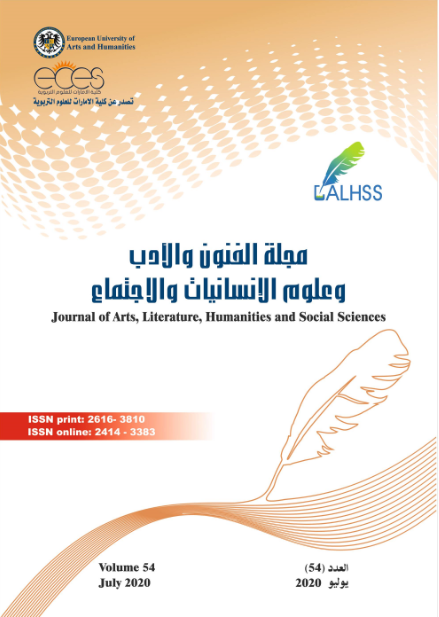The Provenance and Origins of Arabic Calligraphy as an Islamic Art
الملخص
Arabic calligraphy constitutes one of the most prominent and inveterate areas of Islamic art. The study aims to find out the provenance of Arabic Calligraphy and answer the question about what is the origin of Arabic calligraphy? In truth, answering this question is not easy, predominantly because there have been so many diverging opinions. Given its deep and ancient roots, question of its origin is critical. This study attempts to answer this question by examining four major theories regarding the origin of Arabic writing and calligraphy: the theory of restriction and inspiration, the Persian theory, the Musnad theory, and the Nabataean theory. These four theories are reviewed, compared, and analyzed. The results of the study confirm that the origin of Arabic calligraphy derives to a large extent from Nabataean calligraphy and to a much lesser extent from Musnad calligraphy. An additional influence on the appearance and morphology of Arabic calligraphy is Persian Pahlavi calligraphy. The most recent archeological discovery made in Saudi Arabia was an archeological inscription found in a deserted area of Wadi Tharouq, in Daws in Al-Mandaq Province supports this trend. The Saudi Commission for Tourism and National Heritage announced that this stone inscription dates back to the seventh century AD. It is a passage from the Quran. Analysis reveals the similarity between the script of this inscription and Nabatean calligraphy in terms of the composition of the words and the character forms.
المراجع
2. Alansari, A. (1982). Qaryat al-Faw: A Portrait of Pre-Islamic Civilisation in Saudi Arabia. Riyadh: King Saud University publications. p. 146.
3. Allen, R. (2000). The Arabic Language in Theory and Practice. Middle East Studies Association Bulletin, 34(2), 197-199. Retrieved from http://www.jstor.org/stable/23064130.
4. Baglawa, Mhmed. (2016). Dilmon Civilization Rises and Shines Again. Journal of Popular Heritage. 21 (1), 33 - 51.
5. Baluch, Bahman. (2006). Persian Orthography and Its Relation to Literacy,” in Handbook of Orthography and Literacy, ed. R. Malatesha Joshi and P.G. Aaron. London: Lawrence Erlbaum Associates, 365¬–76.
6. Bishop, Brian. (1998). A History of the Arabic Language. Linguistics Journal. 450. 9-19.
7. Deborah, M. (2013). The Queen of Shebai Legend, Literature and Lore. McFarland and Company Inc Publishing. North Carolina. 142.
8. Diamond, Jared. (3005). Guns, germs and steel. The story of writing. Lion Television. Retrieved from www.pbs.org/gunsgermssteel/variables/writing.html.
9. Ibrahim, Ali. (2014). Origins of Arabic writing. Arabic Language Forum. Riyadh. 18/3/2014.
10. Lafi, Badria. (2015). The Impact of Persian Science on the Sciences of the Arabs from the Islamic Conquest to the End of the Abbasid Era. Master’s Thesis. Um Alqura University. 287-289.
11. Mahdi, Salih. (2014). Opinions and Theories on the Origin of Writing. Wasit Journal for Humanities. 12, 89-111.
12. Mousa, I. (2001). The Arabs in the First Communication Revolution: The Development of the Arabic Script. Canadian Journal of Communication, 26(4), 245-261.
13. Omran, Hamdi. (2009). Arabic Writing. Arts College. South of Wadi University. Modern Academy for university books. 82 - 87.
14. Rabi, M., Amrouch M., and Mahani, Z. (2018) Hybrid HMM/MLP Models for Recognizing Unconstrained Cursive Arabic Handwritten Text. In: Ezziyyani M., Bahaj M., Khoukhi F. Advanced Information Technology, Services and Systems. Lecture Notes in Networks and Systems, Springer 25. 115-132.
15. Rahim, Hashim. (2009). Nabatian Theory on the Origins of Modern Arabic Calligraphy. Wasit Journal for Humanities. 5 (10), 139-152
16. Raina, N. & Alotaibi, N. (2018). The History and Development of Arabic Calligraphy. International Journal of Research and Innovation in Social Science. 2(6). 33-51.
17. Razzak, M.I. & Mirza, Ali. (2011). Ghost Character Recognition Theory and Arabic Script Based Languages Character Recognition. Przeglad Elektrotechniczny. 87. 234-238.
18. Showman, Ahmed. (2001). The Journey of Arabic Calligraphy. Damascus: Arabs writers union. 19 - 28.
19. The Noble Quran, Translated by Mohammad Alhilali (Madinah: king Fahad complex for the printing of the Holy Quran, 2013).
20. Zahrani, Ibrahim. (2019). Again, Riyadh Investigated an Important Archaeological Inscription in Albaha. Riyadh Newspaper, July 29, 2019, 3224. p. 17.



